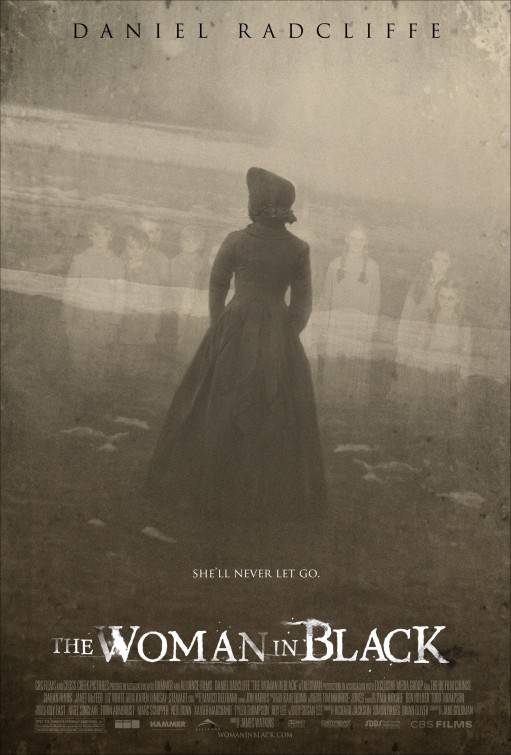Do You Believe In Ghosts?
Director
James Watkins
Starring
Daniel Radcliffe
Ciaran Hinds
Janet McTeer
Liz White
For those who have been reading my reviews since this site’s inception, you will notice a distinct lack of reviews for horror films. In truth, I’m really not a fan of horror, never have been. Having said that, I can appreciate the crafting of a decent horror story but I’m incredibly pedantic about what I watch when it comes to scary stuff. The Woman In Black is a prime example of why I don’t watch horror flicks; I can handle gore, suspense and supernatural occurrences but I simply relish little enjoyment from the actual ‘jumpy scares.’ With this in mind, it’s up to you to decide whether the following is a valid critique or the ramblings of a terrified idiot.
Set at the turn of the 20th century, the story introduces us to widower, Arthur Kipps [Radcliffe], a young solicitor who is struggling with the pressures of his occupation and the responsibility of being a single father. Offered a final chance to redeem himself, Arthur’s employer sends him to a rural town, to secure the estate of the recently deceased Alice Drablow. Upon arrival, Arthur is met with hostility from the locals, all except wealthy landowner Sam Daily [Hinds], who relishes the opportunity of seeing somebody new in town. Despite severe difficulty getting to the estate, Arthur manages to barter with a pony and trap rider to take him to Eel Marsh House, located at the end of a long causeway. Before the rider leaves he explains that the tide comes in and he will return at the end of the day. Arthur’s first visit to the house subtly expands the back-story of the previous tenants but he is interrupted by footsteps and other eerie noises emanating throughout the house. Carefully investigating, Arthur roams the corridors and rooms before finally catching a glimpse of the eponymous character, standing in the small graveyard outside the manor gates. Racing downstairs and outside, Arthur finds nobody but is suddenly plagued by sounds of distress and screaming in the mist. Later, back in the town, Arthur reports his concerns to the local constabulary who merely dismiss them. At the same time, a small group of children enter the police station and explain their sister has consumed lye. Following the death of the girl, Arthur learns that the locals believe that if anyone sees the woman in black, a child dies in a horrible manner and as such, he is being held personally responsible for the incident. Unfortunately, Arthur cannot simply return to London with superstitions and is forced to return to the house until his work is complete.
To my mind, The Woman In Black is a classic ghost story, much in the same vain as the works of M.R. James. The plot is incredibly straight forward but wholly engrossing with its simple premise and chillingly unwavering motive. The plot happily strides along without lagging too much, finding a neat divide between exposition and suspenseful encounters. The rising tension is decently executed, calling on genre classics such as keen use of sound, the unseen and first-rate performances. In addition to the fine plot work and gripping scares, the editing and pacing are exemplary, jolting audiences enough to petrify them and then allowing them a few scenes to catch their breath before immersing them once more. From a technical standpoint, this film is delightfully lush; from the revamped Hammer logo (much in the same style as the Marvel logo that first appeared a decade ago) to Marco Beltrami’s fittingly haunting score and the absolutely pitch-perfect cinematography and production design.
Having said all that, I scare easily and it’s possible that jaded and desensitised contemporary audiences may find it lacking in the over-the-top bloodbaths they are more accustomed to. On top of that, we have to address the whole Daniel Radcliffe thing. Personally, I would say opting for this film was an incredibly wise move but people are going to go into this either loving or hating this actor primarily due to his appearance in the Harry Potter series. I did it myself, as Arthur Kipps takes a train across England I was smirking and making Hogwarts jokes to myself but once the story really begins, it shakes any previous holdings you had on the image of Radcliffe as Potter and screams, “We’re not doing that! This guy is going to get fucked up! Dead kids! Whooo!” until you piss yourself. Which made me somewhat surprised the film managed to get away with a PG-13/12a certificate. Anyone expecting another Potter release is going to be severely freaked out.
Ultimately, I really enjoyed this film (without actually enjoying it because I was fucking scared 85% of the time) and I find it very refreshing that Hammer have returned to the public’s eye with such a strong opening release.
Release Date:
10th February 2012
The Scene To Look Out For:
Hard to say what my favourite scene was, largely because I spent the majority of the film covering my face and cowering like a little girl. I suppose one of the creepiest moments for me was during the night Kipps spends in the house and as he looks out of the window, he sees the a small figure pull itself out of the thick marsh before making its way toward the estate, rattling determinedly on the door handle.
Notable Characters:
I still think Radcliffe has a way to go before the public accept him as anything other than a typecast actor but this is certainly a step in the right direction. For a reasonably budgeted film, it’s a surprisingly small cast, (which is fitting for the period) and everyone performs diligently. As far as standout performance goes, I would probably say Ciaran Hinds (closely followed by Janet McTeer), if only because he portrays the minor elements of fear, dread and forlorn longing that Radcliffe has yet to master.
Highlighted Quote:
“I will never forgive.. never forgive.. never forgive”
In A Few Words:
“Watched through peripheral vision with gritted teeth, The Woman In Black is a brilliantly executed, terrifying classic ghost story”
Total Score: 4/5
![The Red Right Hand Movie Reviews [Matthew Stogdon]](https://reviews.theredrighthand.co.uk/wp-content/uploads/2021/12/cropped-header1.png)




